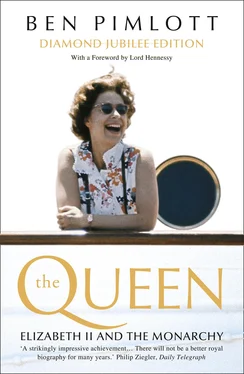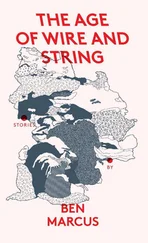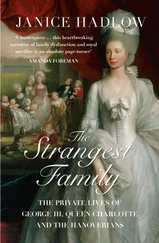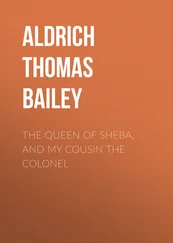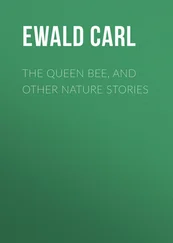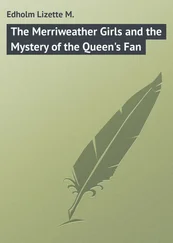On one point there was unanimity: individually and together, roguish and responsible, the princesses were a credit to their parents and the nation. ‘A perfectly delicious pair,’ wrote the diplomat Miles Lampson in his diary in 1934 after seeing the two girls at Birkhall, the Georgian house above the river Muick on the Balmoral Estate, lent by the King to the Duke and Duchess of York four years earlier. ‘I have seldom seen such an enchanting child as Princess Elizabeth.’ 34Their ageing royal grandfather felt the same. ‘All the children looked so nice,’ he wrote after the celebration of his Silver Jubilee in July 1935, ‘but none prettier than Lilibet and Margaret.’ 35
The prettiness of the royal little girls – much more than the handsomeness of the Lascelles little boys – represented youth and renewal, and became one of the symbols of the Jubilee. It was a carnival time, but also a display of recovered national confidence, after the worst of the economic crisis. At the heart of the festivities was the King who – in his proud virtue, sound political judgement, unrelenting philistinism and limited intelligence – stood for so much in an Empire that stretched around the globe: country, deity, family and social order. The crowds were hard to contain.
The nine-year-old Princess Elizabeth was photographed in a carriage with the rheumy-eyed Monarch, grandfather to his peoples as well as to the child beside him. Not since the reign of Queen Victoria, and seldom even then, had a sovereign been so revered (and never, a sceptic might have remarked, on the basis of so modest an achievement). Yet the reverence pointed backwards: Elizabeth stood for the future beyond the present reign. Her portrait appeared on Jubilee stamps, and her personality and looks were compared with those of the erect, austere figure of the Queen. Her appearance, and character, were moulded in the press accounts to fit the requirements of the hour. ‘Fair-skinned, blue-eyed, with regular features,’ was an appropriate assessment, ‘happy-natured but serious and quietly dignified.’ 36
Observing the enthusiasm of the massed well-wishers, the King was reported to be deeply moved. An uplifting year, however, had also worn him out. On Christmas Day he delivered his crackling wireless message to subjects all over the world, but with a noticeably weak voice. Over the next few days, he walked painfully in the estate at Sandringham, stopping every hundred yards to catch his breath. In the evenings, he had just enough energy left to play with his granddaughters. 37Elizabeth had brought cheer to George V during his illness seven years earlier: once again, she appears in the stories told about him. Lord Dawson, the King’s physician, later recounted how, as the end approached, the Archbishop of Canterbury, Cosmo Lang, asked the Princess if she would like to walk with him in the garden at Sandringham. ‘Yes, very much,’ she supposedly replied, ‘but please do not tell me anything more about God. I know all about him already.’ 38F. J. Corbett, formerly Deputy Comptroller of Supply at Buckingham Palace, wrote that the last time he saw George V was on the private golf course at Sandringham, a few days after Christmas. ‘Out of the mist came the King, mounted on his white pony, Jock,’ he recalled. ‘Walking by the head of the pony, as if leading it along, was the little figure of Princess Elizabeth. She was taking her grandfather back to the house.’ 39
On 17 January the princesses returned to Royal Lodge. The Duke of York had his own cause for anxiety in an age before antibiotics, for the Duchess was recovering from an attack of pneumonia. They had barely got home, however, when the Duke was summoned to his father’s bedside. On 20 January, the King died, surrounded by the Queen and his children. Three days later his body was brought with great solemnity to London, and laid in state in the Palace of Westminster, where hundreds of thousands of mourners filed past. Four officers of the Brigade of Guards stood at the corners of the catafalque. On the last night, these were replaced by the dead King’s four sons, including his successor and the Duke of York, each in uniform. Princess Elizabeth was taken by her mother to witness this extraordinary vigil, and to contemplate the coffin of her ‘Grandpa England’. On 29 January, she attended the funeral at Windsor.
The accession of Princess Elizabeth’s young, popular, forward-looking Uncle David as Edward VIII revived the monarchical excitement of the Jubilee. Such an event brings turmoil at Court, similar to the ferment at No. 10 Downing Street caused by the change of a Prime Minister. The hierarchy is turned upside down. Established officials fear for their jobs, or wonder whether the time has come to retire from them. The transition from the predictable George V to his febrile son was a particularly traumatic break, and it sent a tremor through the ranks of the old courtiers. Ancient customs were abandoned, rules and formalities were impatiently relaxed. The Queen was dispatched to live in Marlborough House, and unexpected faces appeared at the Palace.
The new reign also focused attention, with added intensity, on the Yorks. On the margins of the main performance, they continued to enjoy an adequate privacy. A few weeks into the new reign, Harold Nicolson, official biographer of George V, spoke to the Duchess of York at the house of a mutual friend. He talked to her for some time, without recognizing her. 40However, such anonymity could not last long, for the death of the old King, and the persistent bachelorhood of his replacement, brought the Duke of York a step closer to the throne. It also aroused a new kind of interest in his elder daughter. There was still no publicly acknowledgeable reason for expecting Elizabeth ever to become Queen. Yet her place in the line of succession had become much more than a statistic. It began to give rise to speculation, and romantic projection.
What if the King never married? In the run-up to the Coronation, such a possibility was tentatively aired. One commentator suggested that a female Sovereign would be rapturously welcomed, and argued that this in itself was a reason why meddlers into the King’s private affairs should not seek to push him into matrimony. ‘They do not realise how many of their fellow-subjects would, however respectfully, feel half sorry at such an event, however auspicious. It might deprive us of Elizabeth II.’ 41A similar thought may have occurred to Archbishop Lang, who had discussed (or refrained from discussing) theology with the Princess at Sandringham in January, and who stayed as a guest of the Yorks at Birkhall in the summer. At a time when the new King was becoming a serious worry, he was reassured by what he saw. ‘The children – Lilliebet, Margaret Rose and Margaret Elphinstone – joined us,’ he recorded. ‘They sang some action-songs most charmingly. It was strange to think of the destiny which may be awaiting the little Elizabeth, at present second from the Throne. She and her lively little sister are certainly most entrancing children.’ 42
Yet, at first, life for ‘the little ladies of 145 Piccadilly’ did not alter. It may have been a symptom of her upward mobility that a marble portrait bust of Princess Elizabeth was commissioned in the spring of 1936. Over the next two years, Miss Crawford accompanied the child no fewer than eighteen times to the studio of the Hungarian sculptor Zsigmond Strobl in Pembroke Walk. Lajos Lederer, a Hungarian journalist employed to make conversation with her during these tedious sessions, recalled her as highly talkative, and extremely knowledgeable on the subject of thoroughbred horses. 43Otherwise, the only direct effect on the princesses of the accession seemed to be that they saw less of their uncle, previously one of the Yorks’ few frequent callers. The Duke and Duchess, though aware of gathering clouds, continued to ride, garden and embroider, much as before. Lisa Sheridan, visiting their London house before they left for Scotland, was led by a footman into the garden, where she found Princess Elizabeth and her mother feeding a family of ducklings which had wandered in through the railings from the adjoining park. 44
Читать дальше
